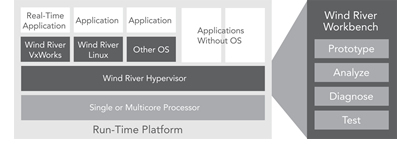Wind River Hypervisor rev’d for new Intel chips
Feb 9, 2010 — by Eric Brown — from the LinuxDevices Archive — 3 viewsWind River released a new version of its Linux-compatible embedded virtualization software for single and multi-core processors. Wind River Hypervisor 1.1 adds support for Intel Nehalem and Core i5/i7 processors, enables new inter-virtual machine communications, and debuts virtual board debugging via the newly revised Wind River On-Chip Debugging, says the company.
Wind River Hypervisor was announced in 2008, and is one of the technological components that led Intel to acquire Wind River last summer shortly after the 1.0 version shipped in June. Wind River Hypervisor is closely integrated with newly enhanced multi-core support in the company's VxWorks real-time operating system (RTOS) and Wind River Linux 3.0 distributions.

Wind River Hypervisor, simplified architecture
While Wind River Hypervisor 1.0 generally supported Intel and PowerPC architectures — the latter primarily those offered by Wind River's long-time partner Freescale Semiconductor — Hypervisor 1.1 extends the software's Intel support. The new version adds support for Intel Nehalem microarchitecture-based processors, such as the Xeon 5500, as well as Core i5 and Core i7 multi-core processors.
According to Mark Hermeling, a senior product manager we spoke with yesterday at Wind River, Hypervisor will support Freescale's PowerPC-based QorIQ, and possibly other platforms later this year. Earlier, Wind River had stated its intention to add MIPS and ARM support, as well.
Intel first?
Placing the initial Nehalem upgrades for Hypervisor ahead of QorIQ is the first hint of Intel favoritism we've seen from Wind River — a company that has gone to great lengths to live up to its promise of platform-agnostic behavior since it was acquired. However, considering the broad interest that has been shown in Intel's recently announced, embedded-oriented Core processors, prioritizing Nehlaem is likely to be a customer-pleasing development.
In fact, Hermeling says that the upgrade decision for version 1.1 was largely in response to the demand from a single large customer. "If you start building systems with many different virtual guests, Nehalem lets you add a lot more memory to the system," he said by way of explaining customer interest in the new Intel support. He also noted, however, that "there's been a lot of interest for virtualization on top of PowerPC processors, as well."
Now available: Virtual board debugging
Wind River Hypervisor 1.1 supports the latest versions of the company's Wind River Linux and VxWorks operating systems, as well as the recently released Wind River On-Chip Debugging 3.2, which is said to be optimized for the development of multi-core, multiple operating systems, and virtualized environments. When used together with the debugging product, which is associated with the version 3.2 of the Wind River Workbench IDE, Hypervisor 1.1 can debug complex system-level issues such as race conditions, memory corruption, and core synchronization, says the company.
Previous to On-Chip Debugging 3.2, users could connect to a processor to try to debug a virtualized system, "but it offered no understanding of the objects and elements of the virtual system," said Hermeling. "Now they can work with a virtual board and gain awareness of all those objects."
Finally, Hypervisor 1.1 adds enhanced support for inter-virtual machine communication, including support for Wind River's MIPC (multicore/multi-OS interprocess communication) IPC technology, as well for virtual network and serial ports. The enhancements allow developers to "create virtual serial connections between different guests," said Hermeling.
Wind River Hypervisor background
Wind River Hypervisor is designed to enable embedded developers to replace multiple boards or CPUs with a single board or CPU, thereby saving on cost and power consumption, says Wind River. Developers can also use the technology to create devices that leverage multiple OSes, and reduce complexity when integrating multi-core processors.

Wind River Hypervisor using supervised AMP architecture
(WR NAE refers to Wind River network acceleration engines; WRE stands for Wind River Executive; click to enlarge)
The technology is billed as a "Type-1" hypervisor supporting real-time features including fast performance, low latency, determinism, and minimal footprint. Wind River Hypervisor offers protection between OSes and cores, and is capable of starting, stopping, and reloading OSes for increased reliability, says the company. The technology is said to support Symmetric Multiprocessing (SMP), Asymmetric Multiprocessing (AMP) and supervised AMP architectures (see diagram above).
The Simics connection
Last week, Intel signed an agreement to acquire Virtutech. Wind River will add the Virtutech product line, including the Simics virtualization and simulation software, to its embedded software product portfolio, said Wind River.
Wind River Hypervisor was developed with the help of Simics, Virtutech told us last year. Hermeling confirmed the Simics connection, and in response to a question about how the Virtutech acquisition might affect Hypervisor's future development, he said that Simics-related technology was indeed likely to affect future developments. However, Wind River has no announcements in this regard at this time, he added.
Availability
Wind River Hypervisor is available now, says Wind River, which did not list pricing. More information may be found here.
This article was originally published on LinuxDevices.com and has been donated to the open source community by QuinStreet Inc. Please visit LinuxToday.com for up-to-date news and articles about Linux and open source.